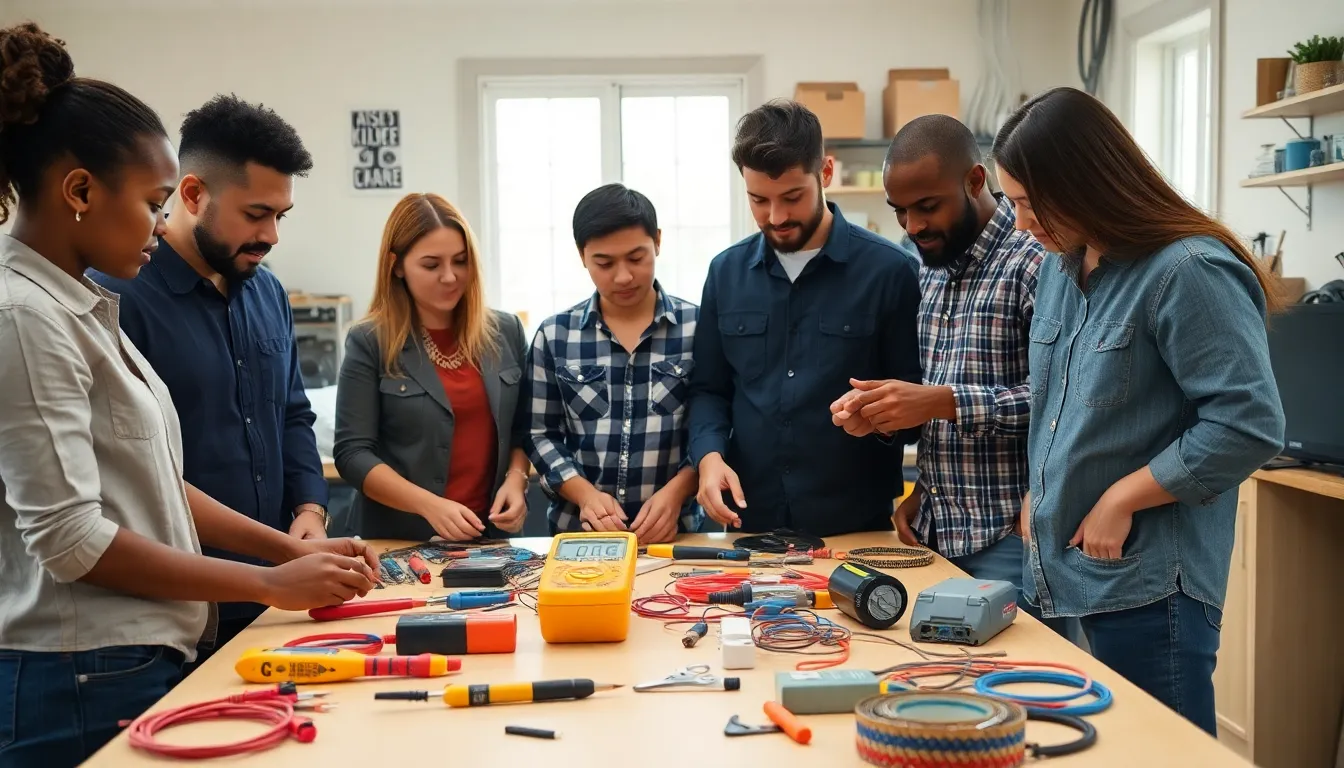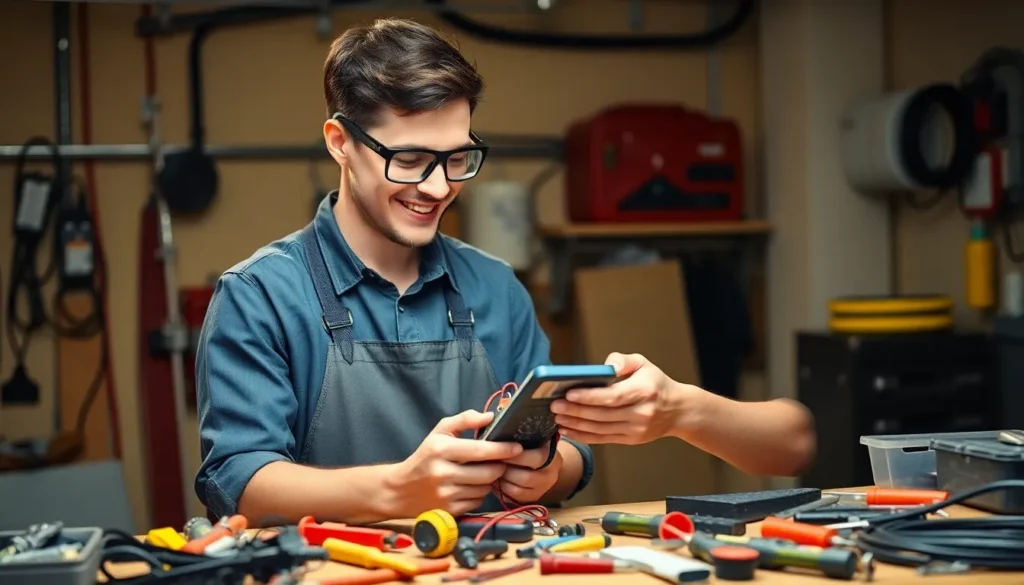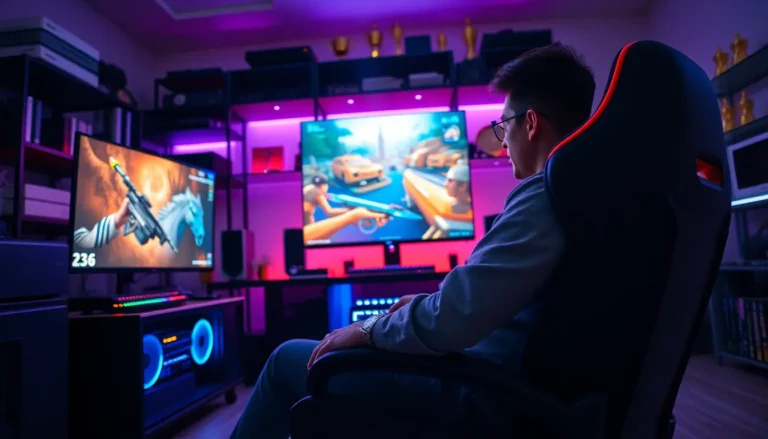In a world where DIY projects reign supreme, electrical work often sparks a mix of excitement and fear. Sure, there’s a thrill in transforming a dull space into a dazzling haven, but the thought of wiring can make even the bravest DIY enthusiast break into a sweat. Fear not! With the right guidance, those wires won’t bite, and that flickering light could become the centerpiece of your home.
Imagine impressing friends with your newfound skills while basking in the glow of your latest creation. From simple lamp upgrades to creating your own smart home gadgets, DIY electrical projects can be both fun and rewarding. So roll up those sleeves, grab your tools, and get ready to illuminate your life—because who wouldn’t want to be the proud owner of a homemade masterpiece that actually works?
Table of Contents
ToggleOverview of DIY Electrical Projects
DIY electrical projects offer a unique opportunity to upgrade living spaces. Engaging in these projects not only enhances functionality but also personalizes environments.
Benefits of DIY Electrical Projects
DIY electrical projects provide cost savings, allowing homeowners to avoid labor charges. They promote skill development through hands-on experience, boosting confidence in electrical work. Customization stands out as a key benefit, enabling individuals to design projects that fit specific needs. Completing such projects instills a sense of accomplishment and pride. Lastly, these projects foster creativity, encouraging innovative solutions to common electrical challenges.
Safety Considerations
Safety remains paramount when engaging in DIY electrical projects. Understanding local electrical codes ensures compliance and reduces risks. Using appropriate tools and wearing personal protective equipment protects against accidental injuries. Always working with the power turned off prevents electrical shocks. Additionally, seeking guidance from experienced professionals when uncertain guarantees proper execution. Regularly inspecting existing wiring helps maintain safety standards and functional efficiency.
Tools and Materials Needed

Completing DIY electrical projects requires specific tools and materials to ensure safety and success. Gathering these essentials simplifies the process and enhances the final results.
Essential Tools for DIY Electrical Work
A multimeter measures voltage, current, and resistance, serving as a multifunctional testing device. Wire strippers remove insulation from electrical wires, allowing for easy connection and installation. Screwdrivers, including both flat-head and Phillips, help secure components effectively. Pliers provide the grip needed for holding wires and making precise bends. A voltage tester confirms that circuits are de-energized, adding a layer of safety. Finally, a circuit breaker finder assists in identifying circuit breakers for easier troubleshooting and maintenance. Each tool plays a vital role in executing various electrical tasks efficiently.
Common Materials for Electrical Projects
Electrical wire transmits electricity and comes in various types, such as copper or aluminum, depending on the application. Sockets and switches are necessary for connecting devices and controlling power flow. Junction boxes protect electrical connections and prevent fire hazards. Circuit breakers ensure safety by interrupting excessive current flow. Electrical tape insulates and secures connections, preventing accidental contact. Wiring connectors enable fast, reliable connections between wires. Each material serves a critical function in ensuring the overall safety and effectiveness of electrical installations.
Popular DIY Electrical Projects
Engaging in DIY electrical projects offers various rewarding opportunities to enhance home functionality. Below are some popular projects that many homeowners successfully tackle.
Installing a Ceiling Fan
Installing a ceiling fan helps improve air circulation and energy efficiency. Begin by turning off the power at the circuit breaker, ensuring safety during installation. Next, mount the fan bracket securely to the ceiling, followed by connecting the wiring according to manufacturer instructions. After that, attach the fan blades and light kit, if applicable. Completing the project requires restoring power and testing the fan to verify proper operation.
Creating Custom Lighting Fixtures
Creating custom lighting fixtures adds unique character to indoor spaces. Start by selecting a base like a pendant or wall-mounted design. After gathering materials such as LED bulbs, wiring, and decorative elements, prepare the electrical connections. Attach the fixture to the existing wiring or an electrical box, ensuring all connections are secure. Lastly, restore power and enjoy the personalized ambiance your new lighting brings.
Wiring a New Electrical Outlet
Wiring a new electrical outlet increases convenience in any room. Begin the project by turning off the power and using a stud finder to determine the best location for the outlet. Drill holes for cables, and connect the wiring to the existing circuit, adhering to local codes. Install the outlet into the electrical box, ensuring a snug fit. Finally, turn on the power and test the outlet to confirm correct installation.
Troubleshooting Common Issues
Troubleshooting common issues in DIY electrical projects often involves careful analysis. Identifying problems early can prevent further complications and ensure safety.
Identifying Electrical Problems
Signs of electrical issues include flickering lights, sparks from outlets, or tripped circuit breakers. A buzzing sound from switches or outlets often indicates faulty wiring. When circuits feel warm to the touch, immediate inspection is crucial. Using a multimeter, users can measure voltage and continuity to diagnose faults accurately. Checking for loose connections, damaged wires, or burnt-out components can reveal hidden problems. Regularly inspecting installations helps maintain an efficient and safe electrical system.
Solutions for Common DIY Errors
Correcting common DIY errors begins with understanding proper installation techniques. Misplacing wires can lead to short circuits, so ensuring correct connections is vital. If a circuit breaker trips frequently, evaluating load capacity might be necessary. It’s essential to secure connections tightly; loose wires can cause arcing and potential fires. Using the right tools for stripping wires and securing connections minimizes errors. For overly complex issues, consulting a licensed electrician prevents complications from escalating. Taking these simple steps significantly enhances the safety and efficiency of electrical projects.
Embracing DIY electrical projects opens up a world of creativity and functionality for homeowners. With the right tools and knowledge anyone can enhance their living space while gaining valuable skills. The sense of accomplishment that comes from completing these projects is truly rewarding.
Prioritizing safety and adhering to local electrical codes ensures that each project is executed without risk. Whether it’s installing a ceiling fan or creating custom lighting fixtures the possibilities are endless. By approaching each task with confidence and care anyone can transform their home and enjoy the benefits of their hard work.




